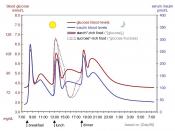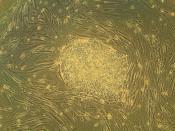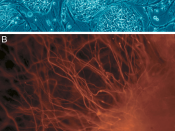A complex disorder, diabetes mellitus afflicts people of every race, sex, age, and cultural background. The form most prevalent in juveniles is insulin dependent diabetes mellitus (IDDM).The diagnosis of this disease has important implications, particularly for the very young. Juvenile IDDM patients may be at risk for neuropsychological problems. In addition, over
the long term, IDDM patients may also suffer from numerous other complications. Fortunately though, advances in technology continue to provide these patients with effective tools for managing their condition. With the introduction of new therapeutic modalities, as well as the
improvement of existing medications, IDDM will eventually become a curable
disease.
Diabetes mellitus impairs the way the body uses digested food for energy. The sugars and carbohydrates in the food we eat are broken down by digestive juices into a simple sugar called glucose. Glucose circulates in the blood as the major energy source for the body.
In order for cells in muscles and other tissues to use glucose for energy, the hormone insulin must be present.
Insulin is produced by the pancreas. When the right amount of insulin is present, glucose is either used as fuel for energy or stored in the liver for future use. In diabetes, however, the
pancreas may not make enough insulin, or the body does not respond to the insulin that is present. Sometimes, a person with diabetes can have both of these problems. As a result, glucose builds up in the blood and tissues, overflows into the urine, and is excreted. Thus, the body loses its main source of fuel. In IDDM, the pancreas makes little or no natural insulin, and a person with IDDM needs daily injections of the hormone to stay alive. IDDM generally occurs in children and adolescents, though it can appear at any age.



Pretty good
A well done essay that is quite infomative.
0 out of 0 people found this comment useful.